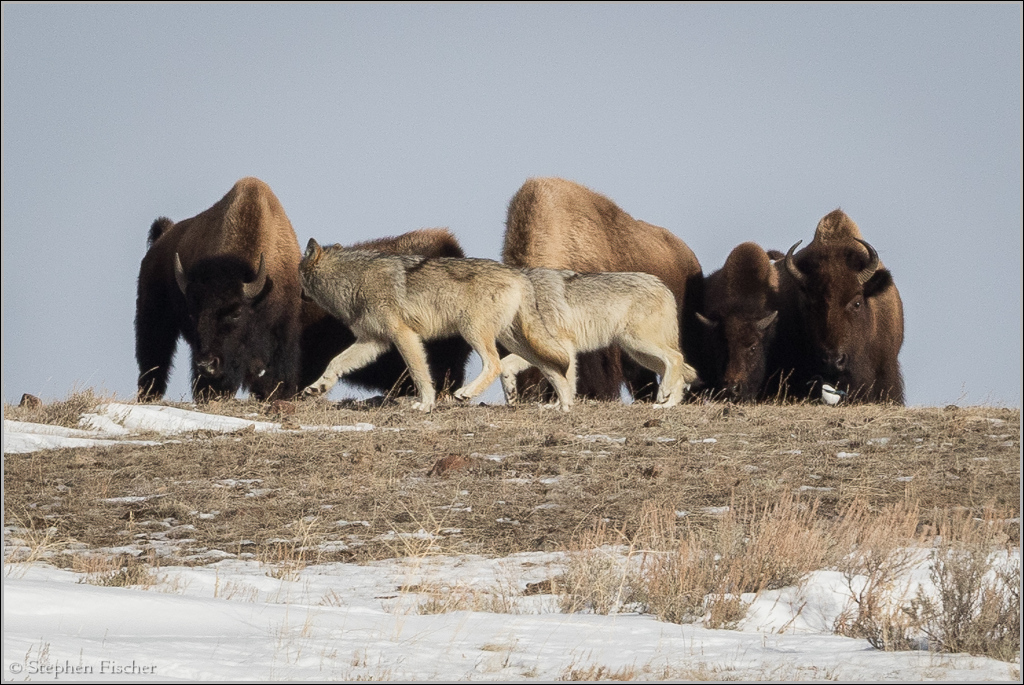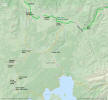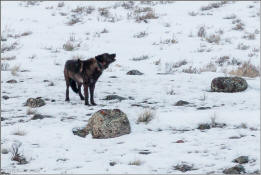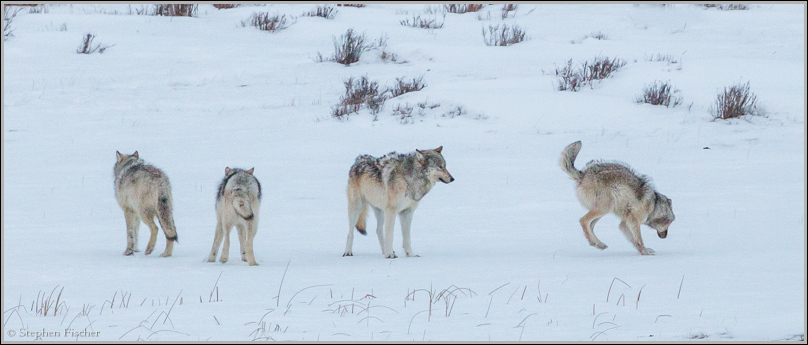Picture of the week
| Previous weeks |
 Dec
12, 2017 Dec
12, 2017 |
 Nov
19, 2017 Nov
19, 2017 |
 Nov
5, 2017 Nov
5, 2017 |
 Oct
22, 2017 Oct
22, 2017 |
 Oct
15, 2017 Oct
15, 2017 |
 Oct
1, 2017 Oct
1, 2017 |
 Sept
10, 2017 Sept
10, 2017 |
 Aug
20, 2017 Aug
20, 2017 |
 Aug
6, 2017 Aug
6, 2017 |
 Jun
18, 2017 Jun
18, 2017 |
 May
28, 2017 May
28, 2017 |
 Apr
30, 2017 Apr
30, 2017 |
| Older |

Wolves and Bison
A pair of wolves checking out a group of bison on the Blacktail Plateau near the northern edge of Yellowstone National Park.
 I just returned from a week long trip to Yellowstone, spending 4 days
exploring the northern end of the park on the 45 mile road between
Mammoth Lodge and Cooke City (see the inset map to the right). This is my second visit during the
winter to Yellowstone for the purpose of wildlife photography (You can
read the trip report of my previous winter visit in 2016
here). The
effort this time did not disappoint, encountering lots of wildlife photo
opportunities including wolves, moose, red fox, big horn sheep, coyote,
elk, and of course the ubiquitous bison. The weather was fairly
typical with a range of conditions from sun to heavy snow, with
temperatures relatively mild for this area between 15 and 30 degrees F
(In my last visit temperatures dropped to as low as -10 deg F).
This time I was more prepared for extended time in the cold with
chemical hand warmers, Goretex insulated boots, and a good down jacket.
I just returned from a week long trip to Yellowstone, spending 4 days
exploring the northern end of the park on the 45 mile road between
Mammoth Lodge and Cooke City (see the inset map to the right). This is my second visit during the
winter to Yellowstone for the purpose of wildlife photography (You can
read the trip report of my previous winter visit in 2016
here). The
effort this time did not disappoint, encountering lots of wildlife photo
opportunities including wolves, moose, red fox, big horn sheep, coyote,
elk, and of course the ubiquitous bison. The weather was fairly
typical with a range of conditions from sun to heavy snow, with
temperatures relatively mild for this area between 15 and 30 degrees F
(In my last visit temperatures dropped to as low as -10 deg F).
This time I was more prepared for extended time in the cold with
chemical hand warmers, Goretex insulated boots, and a good down jacket.
A fellow photographer friend Tucker joined me on this trip, with an extra set of eyes being extremely helpful to better spot wildlife off the road. This allowed me to put more focus on my driving given it is quite hazardous in places due to ice and snow. Thanks to this extra set of eyes we were the first to spot some key wildlife opportunities before any others, including a pack of wolves coming out in the early morning relatively close to the road.
Encountering the
Wapiti Lake wolf pack was probably the biggest
highlight of the trip (as identified by a wolf tracker that I talked to). I counted a total of 13 wolves with this
pack, and was also able to witness the pack leader howling earlier in
the morning. Unlike past experiences, we were able to get relatively
closer at about 100 yards for some of the photography. The pack
hung around along the Blacktail Creek at the western end of the plateau
(and road),
keeping them in our sights for about 2 hours as they slowly progressed
through the valley and the inside of the ridgeline on the farther side. To
photograph them I utilized two camera setups simultaneously:
1. Canon 7D mk2 with a 500mm L f/4 IS mk1 on a tripod with a gimbal head
2. Canon 70D with a 100-400mm L f/4.5-5.6 IS mk2 handheld.
The 500mm lens setup was the go-to camera for many of the captures, but
the handheld setup gave me extra flexibility for some quicker
opportunities or when trying to capture a broader scene. I was
also worried about any type of equipment difficulties (e.g. AF and
exposure behavior) during critical situations like this, so I would
switch between them just to provide a bit more assurance for getting
good results. The
early morning captures were also challenged by the lower light levels,
requiring me to push the ISO up to 6400 in order to maintain a fast enough
shutter speed. I also needed to rely more on manual focusing under
these conditions to get the best results, as the camera's AF sensor
tends to be attracted to the more contrasty sage brush or willow when
the light is low.
Typically we would do two passes each day, once in the morning, and again in the afternoon until sunset. On the second day we decided to just go up to Cooke City for lunch, stopping at a local cafe. hanging out, and then returning to Mammoth in the afternoon on the return pass. While there we talked with the proprietor about the wolves, and they mentioned that the state of Montana plans on issuing hunting tags for wolves soon when found outside the park. All of us thought this was abhorent given how rare this species is and that no animal I am aware is capable of reading signs to know where the park boundary is. Given the federal government already compensate ranchers for any cattle loss due to deprivation by wolves, it is unclear what the logic would be for hunting this animal that has originally roamed these parts longer than white man has been here.
 While
reviewing my photos from the trip back on the computer, I noticed that
the pack leader appears to have a significant wound or gash on the right
side. There seems to be a tuft of hair that looks out of place,
that perhaps is part of a flap of skin that got peeled back just behind
the right foreleg. The inset
picture is shown here while the wolf was howling. Due to the low light
and distance for this particular shot, it is a bit grainy. I suspect it
may have been injured due to an earlier skrimish with a large animal
such as a bull elk or bison. Perhaps it is howling in an effort to
find a member of the pack that is not accounted for? When talking
to a wolf tracker while observing the wolves, he mentioned that pack
count was last known at 15 and was high as 20, but I only counted 13.
While
reviewing my photos from the trip back on the computer, I noticed that
the pack leader appears to have a significant wound or gash on the right
side. There seems to be a tuft of hair that looks out of place,
that perhaps is part of a flap of skin that got peeled back just behind
the right foreleg. The inset
picture is shown here while the wolf was howling. Due to the low light
and distance for this particular shot, it is a bit grainy. I suspect it
may have been injured due to an earlier skrimish with a large animal
such as a bull elk or bison. Perhaps it is howling in an effort to
find a member of the pack that is not accounted for? When talking
to a wolf tracker while observing the wolves, he mentioned that pack
count was last known at 15 and was high as 20, but I only counted 13.
If you want to learn more about wolves, a good summary can be found by
the NPS
here.
More images (click to select the larger view at the bottom)



All content and images are property of Stephen Fischer Photography, copyright 2010-2018. Last updated: 2/11/2018 ()